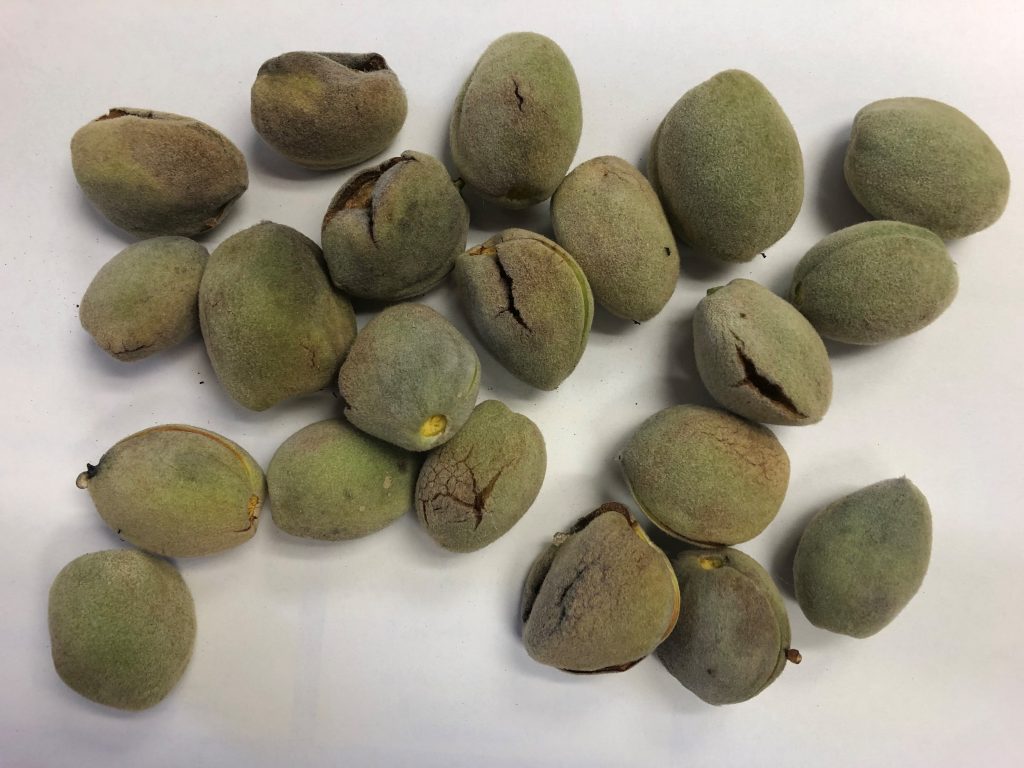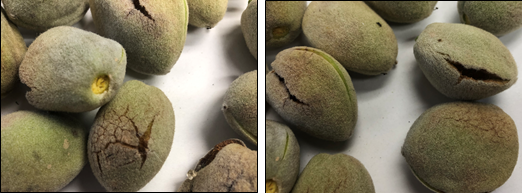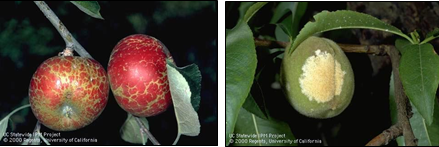Written by Cameron Zuber, UCCE Merced County
Some interesting almonds came into the office and, no, this is not a setup for a joke.

In the middle of July, some almond fruit nuts from Le Grand, CA were brought into the Merced County UC Cooperative Extension office. There were various signs of possible pest damage and disease infection. These included black growth inside the hull indicating possible Rhizopus stolonifera fungus which may lead to hull rot; grayish-black spots indicating scab (Cladosporium carpophilum); and gumming which may indicate bacterial spot (Xanthomonas arboricola pv. Pruni), anthracnose (Colletotrichum gloeosporioides), or bug feeding.

However, the greatest amount of damage were odd areas of russeting and cracking on the hull.

After speaking with person who brought in the samples, there was not any indication of leaf or shoot die back near the nuts which starts to rule out hull rot and lab tests did not show any fungi that would cause hull rot. Lab test also showed some instances of almond scab growths, but none of these pest or disease symptoms were at a level to be extremely concerned about. Also, none have been shown to cause the odd cracking on the hull, so what was the cause, should you be worried about it, and how do you fix it?
The cause was found through some digging and a lot of help from farm advisors and plant pathologists. It was determined that the cause was most likely a false powdery mildew (or powdery mildew-like) fungus of the Acremonium species. Normally these organisms live on dead or decaying organic matter (i.e., saprophytes), but do occasionally infect plant material and, for almonds, result in the russeting and cracking seen in the above fruit nuts. It is called “false” or “like” powdery mildew because it shows similar symptoms of powdery mildew on other crops like those seen in apples (Podosphaera leucotricha) and peaches (Sphaerotheca pannosa) but is not directly related to those organisms.

As to worry, the UC IPM website notes that, “the disease is rarely an economic problem on almonds in California,” and the damage to the fruit nuts that were brought into the office seemed to be located only in the hull.
At this point, fixing the issue would probably be moot as there did not seem to be an immediate concern for the current year’s crop, and, as with most things with pest and disease management, the solution is normally prevention. However, finding products that are effective for this specific fungus of Acremonium species is difficult due to the challenge with identify it through lab assessments. If you have this issue, please consult with your local farm advisor or PCA. Current UC IPM recommendations for prevention are fungicide applications during jacket-split and mid-spring (e.g., April and May in California).
We would like to acknowledge and thank Jim Adaskaveg (professor and plant pathologist with UC Riverside), Themis Michailides (plant pathologist and lecturer with Kearney Agricultural Research and Extension Center), and Brent Holtz (Farm Advisor with UC Cooperative Extension in San Joaquin County) for their help with identifying this disease. We would also like to give a special thank you to the grower for allowing us to share their story.
The Almond Doctor Field Note is a series of posts that will cover observations made from the field by staff research assistants of the University of California Cooperative Extension office of Merced County. While Field Note posts may reference completed or on-going research, its intent is share notable observations from the field, not to summarize research findings or describe current recommended farming practices.

